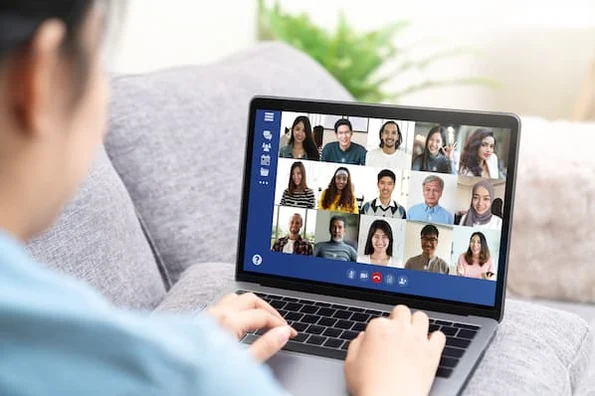What is virtual meeting etiquette?
Virtual meeting etiquette is the set of rules and guidelines that participants must follow during a virtual call with co-workers. Although you’re not in the same physical space as your colleagues, it’s still important to maintain professionalism and respect for everyone in the meeting.
For instance, you should still be on time for virtual meetings, just as you would for an onsite meeting.
Importance of virtual meeting etiquette
Virtual meeting etiquette should be the foundation businesses use to promote effective communication among employees.
Proper etiquette during virtual meetings can achieve this by:
- Maintaining respect for everyone: Having guidelines that promote fairness during meetings will ensure everyone feels heard and valued.
- Keeping meetings focused: Meetings that go off track can be unproductive and a waste of time. Effective rules can help keep presenters stick to relevant topics and prevent participants from veering away from the purpose of the meeting.
- Ensuring professionalism: Different employees may have different ideas about dress codes and meeting behaviors. Having rules for attire and mannerisms will ensure everyone’s on the same page.
Virtual team meeting etiquette
Establishing ground rules for your virtual meetings will ensure no one makes the mistake of offending their colleagues, boss, or client.
Here’s a nonconclusive list of remote meeting rules you can employ to improve productivity.
1. Arrive on time (and end on time)
Set a time for an upcoming meeting and notify everyone of when it’ll occur. Ask team members to arrive five minutes early, so no one’s waiting around when the meeting starts. This is especially critical for key speakers who will present information.
It’s also ideal to set a time limit for speakers and topics to ensure the meeting ends on time. If needed, do a hard stop and then continue the discussion in the next meeting or follow up with a post-meeting email.
2. Avoid multitasking
It’s tempting to check your email, texts, and other apps during a call. Yet this is poor etiquette, even if you’re not speaking during the meeting. Encourage attendees to be more engaged by turning off their phones and computer notifications.
3. Notify others before leaving
Dropping out of a meeting without warning leaves others wondering what happened. This may halt the meeting while they wait for your return, even if you don’t plan to get back.
Be courteous and let others know you must leave the meeting early. If you know this in advance, then let your team know to expect your departure at a specific time.
4. Don’t disrupt speakers
There are scenarios where interrupting the speaker to ask a question once or twice is OK. But if it happens too often, it can prolong the meeting and frustrate others.
Instead, use the chat function to ask questions, or the raise hand function to indicate you have something to say. This will minimize disruptions, and the speaker can contact you later if a question went unanswered.
5. Take notes (without the clickety-clack of your keyboard)
Taking notes during meetings is a good way to keep track of critical information, but it can also be a distraction. It removes you from the discussion — and if you’re using a keyboard and aren’t muting your microphone, then the sound of clicking keys might distract your team.
The alternative: Write notes with a pen and paper, or use a tool like Otter.ai to record and transcribe the meeting automatically.
- Mute yourself when you’re not talking
Turning off the mic when you’re not talking ensures unexpected noise and disruptions don’t interrupt the speaker, though you could make the occasional exception.
“Some virtual meeting facilitators recommend all attendees mute themselves at the beginning of sessions,” says career coach Dr. Kyle Elliot. “Assess if this makes sense for your meeting. For example, having dozens or hundreds of unmuted attendees can quickly become disruptive. But asking participants to keep themselves unmuted in smaller meetings can lead to livelier conversations.”
7. No munching on snacks
Some meetings run into lunchtime or dinnertime for participants. It’s difficult to pay attention when your stomach’s growling, so snacking on a bag of chips or a few cookies seems ideal — but not with your camera and mic on. If you’re going to snack, turn both off until you’re done. Give your teammates a heads-up that you’re going silent, but will continue listening.
8. Create and send the meeting agenda to participants
Meetings are more productive when the right people are attending and they’re prepared to engage. By creating an agenda, you can identify who needs to attend. And sending participants an outline allows them to prepare ahead of time.
9. Be mindful of time zones and cultural boundaries
If you’re working with teams across the globe, be mindful of the day and time you choose for your meetings. Some members may have religious practices, such as no work on the Sabbath (e.g., Friday evenings). Others may have to stay up well past midnight to accommodate your lunch-hour meeting.
If you’re unsure, then send out an email offering days and times for everyone to vote on. Worst case, you can send a recording or notes from the meeting if someone can’t attend.
10. Look at your camera and speak clearly
It’s tempting to gaze around the room or at the participants on your computer screen while speaking in a virtual meeting. However, this makes you feel disconnected since you’re not looking at the participants straight on.
Staring into your camera eliminates this issue. Try taping a photo near the camera to direct your eyes to the right place.
This is also a good practice you should implement to ensure you have effective meetings. For more tips, check out this video.
11. Introduce members of the team
If you’re having a meeting with clients or others outside of your business, then introduce each person and their role. Another option is to have each person introduce themselves. You can call on each person so it’s done in an organized fashion (vs. multiple people talking at once or no one taking the initiative to go first).
Virtual meeting etiquette tips for one-on-ones
Often, you may be meeting with a team member or manager alone. Here are a few tips for when you’re going into a one-on-one meeting:
- Turn on your mic and camera: Since this is a one-on-one meeting, it’s better to have both on to keep the conversation engaging. Plus, it’s awkward staring at a black square or hearing nothing from the other end during a two-way conversation.
- Actively listen: Since you’re the only other person on the call, it’s rude to look away from the camera for long stretches or type away on your keyboard. Pay attention to the participant, and use verbal and physical gestures to show you’re following along.
- Test your equipment before: Having technical difficulties during a one-on-one meeting is worse than in a team meeting, because without you the meeting can’t move forward. So test your camera, lighting, and audio to ensure it’s working. If you’re using a new platform, practice and make sure you know how it works.
Virtual meeting etiquette for participants
Participants in a meeting are those who aren’t presenting — including those who are outside of your company. It’s ideal to have ground rules for team members and outsiders to follow to ensure the best experience for everyone.
For example, you can request:
- RSVPing to the meeting
- Beginning with introductions
- Having cameras on at the start of the meeting
- Muting the mic while not talking
- Using the chat feature to ask questions or share information during a presentation
- Arriving before the meeting begins
- Finding a quiet and private place to have the meeting
- Not eating any food during the meeting (drinks are fine)
- Learning the software controls in advance
Your meetings are only as great as the mannerisms and behaviors of its participants — so ensure everyone’s respectful of each other’s time, ideas, and comfort.
Meetings









![Do You Really Need to Hold That Meeting [Quiz + Tips]](https://53.fs1.hubspotusercontent-na1.net/hubfs/53/time-wasted-meetings-data_2.webp)


